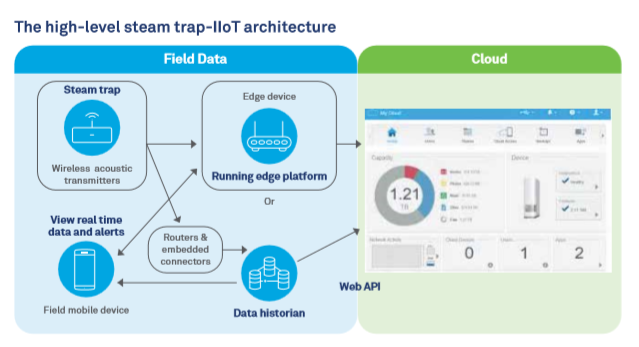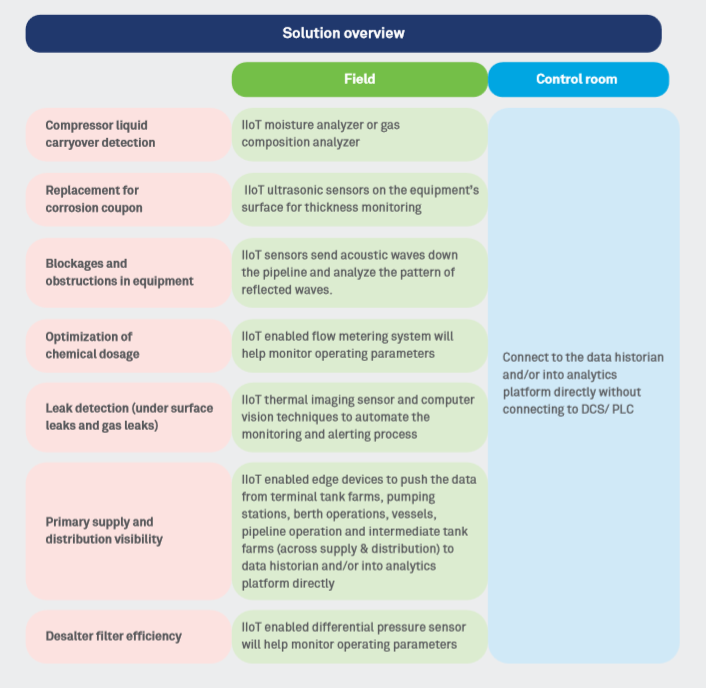In this age of connectivity and mobility that has enhanced user-oriented patterns in every aspect of life, there is an impending need to apply this concept to industries and more specifically to a traditional industry like Oil & Gas. This point of view is an enabler to the direction that will allow connecting the unconnected aspects of refining, leveraging the robust platform of Industrial Internet of Things (IIoT).
Current scenario and gap
Present global refineries are all highly instrumented and are process controlled in real time on a millisecond basis. Distributed Control Systems & Programmable Logic Controllers (DCS & PLCs) have evolved in a significant way to cope up with the ever-increasing demands of operational demands. However, there are certain assets and processes in a refinery that are still not being monitored or analyzed on a real-time basis. These assets and processes are not super critical regarding refinery process control or safety or operational bottlenecks and hence not mandatorily monitored through DCS/PLCs. The reason maybe is they are not economically viable to route through DCS/ PLC. They are primarily monitored periodically and sometimes through manual intervention only. Analysis of performance history or failure prediction is not possible. Few examples of these type of assets and processes are steam traps, pressure relief valves, corrosion monitoring, catalyst life, liquid carryover in compressors, dosing chemicals, primary supply & distribution, etc.
However, if there is a more cost-effective way of monitoring them on a real-time basis, they can contribute significantly to improving the productivity, efficiency, asset life, process safety and hence the GRM.
What’s new to enable change
Advancement of technology and Industrial Internet of Things (IIoT) is inspiring new and innovative ways to boost operational efficiency. It has opened up more accessible and more cost-effective channels of monitoring processes. This will enable all those assets and processes to get connected and monitored on a realtime basis in a simpler, cost-effective and easy to implement manner that were hitherto unconnected. This will enable the below possibilities:
How it works
To illustrate with an example of how IIoT enables connecting the unconnected, consider the common Pressure Relief Valve (PRV). The PRV is supposed to discharge excess gas from containers and pipes beyond a set pressure. Over a period, springs in the PRVs suffer from fatigue and their set-points change and the PRVs start leaking gas into the environment at a lesser pressure. This leads to lost products and environmental and safety hazard. PRVs are un-instrumented and also mounted in inaccessible places making manual inspection challenging. Therefore, they are left to be tested only during turnarounds/shutdowns. However, the recent stringent safety regulations have made it mandatory to monitor PRVs electronically. The solution is to add an IIoT differential pressure sensor across the PRV that will monitor the health of the PRV in real time.
This will transmit the real-time information directly to Data Historians or to IIoT Platforms-without having to be connected to the DCS or PLC. Any malfunctioning PRVs will be detected immediately on real time and can be actioned upon without having to wait for months for the next shutdown. Imagine this happening for all the thousands of PRVs in a refinery. Studies have shown that real-time monitoring of all PRVs in a refinery can potentially lead to additional ~20% savings in operating costs .
Another example can be the steam traps. Steam traps are currently monitored monthly. So any steam trap failure will wait for about 20 to 30 days before it gets replaced. The impact is condensate held up in steam lines or steam passing to condensate header; both scenarios lead to inefficient heat transfer and process operation. An IIoT enabled acoustic sensor can be mounted on the steam trap. Once a steam trap fails, it will emit sound greater than the desired decibel. The IIoT sensor can send the information directly to the data historian for realtime monitoring and analysis-enabling instant action and replacement of the steam trap as soon as it fails, instead of waiting for the next inspection after 30 days.
Typical architecture in case of a steam trap is shown as below:

The fundamental architecture for a connected solution involves:
Site area: Retrofitting equipment with appropriate IIoT sensors, connecting distributed equipment and pushing the data out through a communication gateway to the data historian or IIoT platform
Security: Ensuring data security between the sensor and the receiver platform
Receiving system: The data from the sensor can come directly to the data historian or IIOT platform. The historian will store data, perform analysis-corrective/advanced/predictive/ prescriptive, enable KPI dashboards, visualization and mobile messaging/access to enable corrective action in real time
Unlocking hidden value
A long list of such assets and processes can benefit from the above solution. Some examples:

Facing the challenges
To implement the above and make it a reality, a refinery may face several challenges. There could be interoperability issues, inability to identify right business cases, lack of technological maturity and a dearth of the required technical skills. However, these are not intractable challenges. A majority of them can be quickly addressed. Wipro’s digtial frameworks and tools help organizations identify the right opportunities, mitigate challenges, and architect solutions with a contextual roadmap.
Arnab Sarkar
Global Head of the Oil & Gas Manufacturing Practice, Wipro
Arnab Sarkar leads a global team of domain and technology professionals in the areas of Manufacturing Execution System. Over a period of 22 years, Arnab has had extensive experience in Greenfield Refinery Implementation & Commissioning, Plant Maintenance in Refineries, IT enablement of Brownfield & Greenfield Plants across roles of go-to-market, solution design, delivery and project management of large complex programs.
In his role as a practitioner, he has successfully built centres of excellence with domain capability to win and deliver multiple projects globally from consulting, end-to-end implementation, integration, run & maintain of MES applications for refineries mainly in the areas of asset reliability & integrity, planning & scheduling, data reconciliation and yield accounting, operations management, performance management and real time systems. In his current role he is responsible for advising clients on IT enablement of manufacturing plants, creating innovative solutions and developing competencies that can provide the right technology enablement in a challenging industry environment.
Ramesh Srinivasan
Managing Consultant in Wipro
Ramesh Srinivasan is a Energy Downstream Practices and is working in the areas of Manufacturing Execution Systems (MES) for refineries. Over a period of 14 years, Ramesh has had extensive experience in implementing MES for refineries and also involved in solutions design, build, integrate and deliver.
In his role as a managing consultant, he has successfully led or mentored multiple projects in India and abroad for end-to-end implementation and integration of MES applications for refineries in the areas of Planning & Scheduling, Data Reconciliation and Yield Accounting, Operations Management, Performance Management and Real Time Systems. In his current role he is responsible for advising clients on MES systems, creating innovative solutions and developing competencies that can provide the right technology enablement in a challenging industry environment.